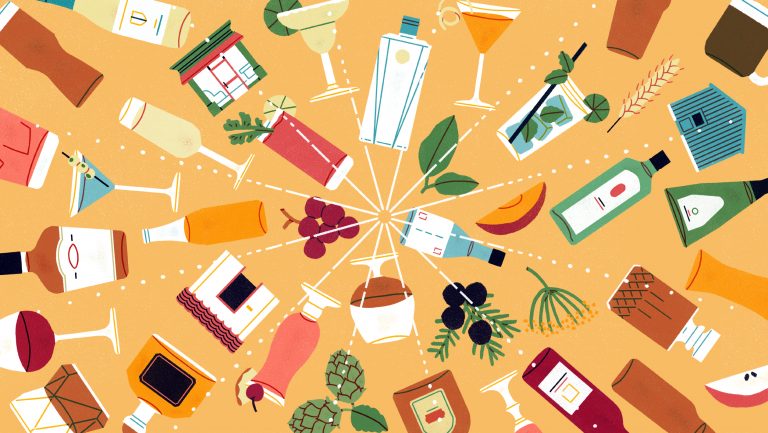After several rounds of temporary enactments, craft distillers have finally achieved permanent federal excise tax (FET) reduction with the passage of the Craft Beverage Modernization & Tax Reform Act in December 2020. This keeps in place the temporary reduction of FET on spirits from $13.50 to $2.70 per proof gallon on the first 100,000 proof gallons removed from bond annually—a boon for craft distillers, as 98 percent of craft distillers in the country produce less than this annually, according to the American Craft Spirits Association (ACSA).
This legislative achievement has a direct bottom-line impact for craft distillers, and combined with progress around regulations like direct-to-consumer (DTC) shipping and on-premise cocktails to-go, the craft spirits industry is preparing for growth ahead—albeit cautiously. Small and medium-sized producers were hit particularly hard by lost revenue as a result of the pandemic, and sales have not yet fully returned. There’s also the matter of the EU and U.K.’s tariffs on American whiskey, which are set to double in June.
As the craft distillers begin to see a light at the end of the tunnel after fighting through hardship, what’s ahead for the American craft spirits industry?

Don’t miss the latest drinks industry news and insights. Sign up for our award-winning Daily Dispatch newsletter—delivered to your inbox every week.
Opportunities for Immediate Growth
The impact of permanent FET relief is massive—and could be felt immediately, allowing distillers to invest in upgrades. “My own distillery was finally able to make a deposit on a million-dollar plant expansion project that we have been postponing for multiple years,” shares ACSA president Becky Harris, the co-founder and distiller of Catoctin Creek.
“Nearly every distiller I know has expanded production through upgraded equipment, improved systems, increased staff, and many have even moved into larger facilities,” says Jaime Windon, the founder of Lyon Rum and president of the Maryland Distillers Guild. Windon increased Lyon’s production capacity and hired new staff; Melissa Katrincic, the co-founder and CEO of Durham Distillery, says she’s been able to keep prices more competitive with larger brands; Jeff Quint, the founder and CEO of Cedar Ridge Distillery, has invested in $500,000 of new production equipment and begun construction on a new building; Keith Bellinger, the president and COO of Balcones Distilling, says he was able to invest into additional personnel, production upgrades, and sales and marketing.

Accelerated Push for DTC
The pandemic also greased the bureaucratic wheels on longstanding regulations that the industry has been trying to change. “The pandemic has accelerated innovation and marketplace modernizations in the spirits industry,” says Chris Swonger, the president and CEO of DISCUS.
“The impact of COVID-19 has only pushed some of these regulations to the forefront and made many consumers start to question the entire alcoholic beverage system,” says David Large, director of industry consultancy Thoroughbred Spirits Group. “National shipping, on-site distillery regulations, direct-to-consumer sales, and third-party shipping are all topics facing the industry over the next few years.”
DTC tops the list: Ten states, plus Washington, D.C., allow for DTC spirits sales, while six states are permitting in-state DTC spirits shipping as a temporary relief measure. “As distillery tasting rooms shuttered due to pandemic restrictions, another major takeaway was the importance of having expanded sales channels for distilled spirits and the need for modernized regulations that allow distillers to quickly react to changing consumer preferences,” Swonger says. “Consumers are the real driver for direct-to-consumer shipping of distilled spirits, and public support for this convenience has gained momentum due to the pandemic.”
Systems are already in place to ensure the safe and appropriate application of DTC spirits shipping, says Philip McDaniel, the CEO of St. Augustine Distillery and DISCUS Craft Advisory Council member. “Wine has successfully navigated these issues for over two decades [45 states allow DTC wine shipping] and allowing DTC sales for spirits would be a massive step forward for our industry,” he believes.
The payoff for distillers was real in states where a pandemic allowance for DTC was made, such as New York and Virginia, with an American Distilling Institute (ADI) survey of 269 distilleries conducted in January indicating that distilleries who could ship DTC in 2020 generated 39 percent of total sales through the channel. “During COVID, we have been allowed to reach our consumers safely at home with the allowance of DTC shipping,” says Brian Facquet, the founder of Do Good Spirits, president of the New York State Distillers Guild, and a DISCUS Craft Spirits Advisory Council member. “While some of our members have had to close, DTC has allowed many of us to survive.”
As it’s a matter of state legislation, so change happens locally. But once the ball gets rolling, momentum can lead to swift change across the country. Just look at cocktails to-go: A relatively niche idea a year ago, 30 states plus Washington, D.C. are allowing cocktails to-go from bars and restaurants, with D.C., Iowa, Ohio, and Kentucky having made such measures permanent. The push is on to see a wider permanent application there, too, many distillers believe.
Confronting Revenue Losses and Harmful Tariffs
Despite optimism, there are still a number of pressing concerns for craft distillers. Despite positive reports of increased alcohol purchasing, many producers are still reeling from revenue losses. ADI’s aforementioned survey showed that 55 percent are reporting declining revenues, while a survey released last August by the Distilled Spirits Council of the United States (DISCUS) indicated that craft spirits sales had dropped 41 percent overall—a total of$700 million.
While DISCUS also reports that total U.S. liquor sales were up in 2020, that obfuscates how heavily the gains went to large brands backed by multinational companies. Craft distilleries which bore the brunt of the economic beating without the ability to host tastings and tours or move product on-premise amidst widespread closures.
“We’re on a climb and it’s a flight of 20 stairs—we’re two or three steps up,” says Monique Huston, Winebow‘s vice president of wholesale spirits. For example, many reopened bars are sitting on unused inventory and don’t need to place orders. “We’re also seeing that people are cutting down what’s available. They’re doing fewer cocktails, fewer ingredients, much, much-slimmed down drinks lists.”
Interestingly, the opposite is happening with at-home imbibing; a trade-up trend to higher-end expressions which has benefited many craft distillers’ off-premise sales, Huston points out: “Everything is premiumized! That’s the way everything is going. Our business for products $50 and up has increased triple digits, quarter on quarter on quarter, through the whole pandemic.”
There were positive signs earlier this year that the harmful tariffs against U.S. spirit exports to the EU and U.K. could end; however, that battle might actually get worse before it gets better. “While the recent U.S. and EU agreement to suspend tariffs on spirits products for four months is a promising breakthrough in the longstanding trade dispute on civil aircraft subsidies, the EU and U.K. continue to impose a 25 percent tariff on American whiskey in the steel and aluminum dispute, [and the EU’s] will double to 50 percent on June 1,” Swonger says.
A new coalition dubbed Toasts Not Tariffs, launched in March, brings together 47 industry organizations united against tariffs, while in early April, congressmen Andy Barr and John Yarmuth, backed by a bipartisan group of 48 additional members of Congress, sent a letter to Katherine Tai, President Biden’s newly-confirmed U.S. Trade Representative (USTR), pressing the importance of the issue. American whiskey exports have declined by 37 percent to the EU and 53 percent to the U.K. as a result of the tariffs, and their doubling would devastate the market and tarnish what had been a promising channel of growth for craft distillers.
“Before 2018, export was a great opportunity to build a brand in a region thirsty for American whiskey,” Harris says. “Until American whiskey is removed as collateral damage from this dispute, one of the largest whiskey export markets in the world is effectively blocked.”

Harnessing the Power of Community
If every challenge is an opportunity, the constant pivoting of the past year has shown craft distillers that there are other ways to succeed in the market. There’s a clear need to diversify business plans—something that DTC is a core piece of, along with cocktails to-go—so that if and when on-premise sales or on-site tastings aren’t feasible, there are other avenues of promotion and revenue generation.
For Katrincic, much of what she’s seen in the past year goes back to the saying “own the home,” which she says she received as advice when starting Durham Distillery. “I didn’t take that lightly back then, and it fit naturally into our ethos,” she says. “The distillery continuously has prioritized giving back to the community through good works, we have always been a living wage employer and our relationships with fellow businesses are paramount to who we are. All of last year, our community showed up to support us… the local community is the reason why we survived 2020.”
Craft distillers are small, local businesses, and the power of community cannot be understated. Facquet says that surviving the past year was a test of character for distillers, businesses which are more fragile than many may have realized. “However, I believe we have a bright future as we find new ways to reach our consumers,” he says. “We are a community of distillers who are working together to rebuild, advocate for small businesses, and make an impact on our communities.”
As the craft distilling industry has given so much to their communities over the past year—more than 800 distilleries produced hand sanitizer amidst supply shortages, according to DISCUS—it’s important for both consumers and trade to support them, with the products we choose to buy, as well as with support for the legislative hurdles which remain.


